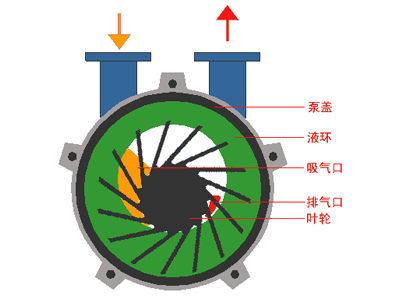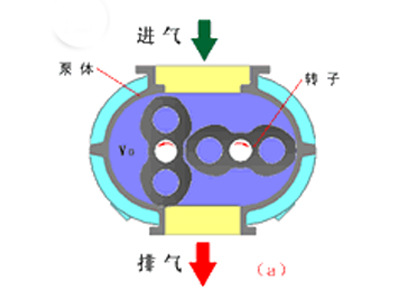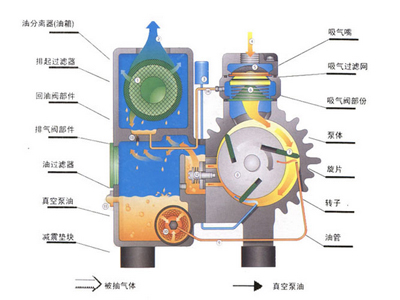The working principle and function of the vacuum pump will be explained in detail by the Shanghai Bashu technicians. Welcome to the following details: First, the working principle of the vacuum pump 1. Working principle of water ring vacuum pump / liquid ring vacuum pump The water ring vacuum pump (referred to as the water ring pump) is a rough vacuum pump, which can obtain an ultimate vacuum of 2000~4000Pa and a series atmospheric injector of 270~670Pa . The water ring pump can also be used as a compressor, called a water ring compressor, which is a low pressure compressor with a pressure range of 1 to 2 × 105 Pa gauge. The water ring pump was originally used as a self-priming pump and was gradually used in many industrial sectors such as petroleum, chemical, machinery, mining, light industry, medicine and food. In many processes of industrial production, such as vacuum filtration, vacuum water diversion, vacuum feeding, vacuum evaporation, vacuum concentration, vacuum regain and vacuum degassing, water ring pumps are widely used. Due to the rapid development of vacuum application technology, water ring pumps have been paid attention to in the acquisition of rough vacuum. Since the gas compression in the water ring pump is isothermal, the flammable and explosive gas can be removed, and the dusty and water-containing gas can be removed. Therefore, the application of the water ring pump is increasing. An appropriate amount of water is contained in the pump body as a working fluid. When the impeller rotates clockwise in the figure, the water is thrown around by the impeller. Due to the centrifugal force, the water forms a closed ring of approximately equal thickness depending on the shape of the pump chamber. The inner surface of the lower portion of the water ring is just tangent to the impeller hub, and the upper inner surface of the water ring is just in contact with the tip of the blade (actually the blade has a certain depth of insertion within the water ring). At this time, a crescent-shaped space is formed between the impeller hub and the water ring, and this space is divided by the impeller into a plurality of small cavities equal to the number of blades. If the lower part of the impeller starts from 0 °, then the volume of the small cavity becomes larger from 180 ° before the rotation , and it communicates with the suction port on the end face. At this time, the gas is sucked in, and when the inhalation is finished, the cavity is small. It is isolated from the suction port; when the impeller continues to rotate, the small cavity becomes larger and smaller, so that the gas is compressed; when the small cavity communicates with the exhaust port, the gas is discharged outside the pump. In summary, the water ring pump relies on the change of the volume of the pump chamber to achieve the suction, compression and exhaust, so it belongs to the variable displacement vacuum pump. 2 , the working principle of Roots pump The Roots pump is in the pump chamber, and two " 8 "-shaped rotors are mounted perpendicularly to each other on a pair of parallel shafts, and a pair of gear belts with a transmission ratio of 1 are synchronized with each other in a synchronous rotational motion. Between the rotors, there is a certain gap between the rotor and the inner wall of the pump casing to achieve high speed operation. Since the Roots pump is a vacuum pump without internal compression, the compression ratio is usually low, so the high and medium vacuum pumps require a foreline pump. The ultimate vacuum of the Roots pump depends on the structure and manufacturing accuracy of the pump itself and on the ultimate vacuum of the foreline pump. In order to increase the ultimate vacuum of the pump, the Roots pump can be used in series. The Roots pump works like a Roots blower. Due to the continuous rotation of the rotor, the pumped gas is sucked from the intake port into the space v0 between the rotor and the pump casing , and then discharged through the exhaust port. Since the v0 space is fully closed after inhalation, the gas is not compressed and expanded in the pump chamber. However, when the top of the rotor turns over the edge of the exhaust port and the v0 space communicates with the exhaust side, since the gas pressure on the exhaust side is high, a part of the gas is returned to the space v0 , so that the gas pressure suddenly increases. When the rotor continues to rotate, the gas exits the pump. 3 , rotary vane vacuum pump working principle The rotary vane vacuum pump (referred to as the rotary vane pump) is an oil-sealed mechanical vacuum pump. Its working pressure range is 101325~1.33 × 10-2 ( Pa ), which belongs to the low vacuum pump. It can be used alone or as a foreline pump for other high vacuum pumps or ultra high vacuum pumps. It has been widely used in the production and scientific research departments of metallurgy, machinery, military, electronics, chemical, light industry, petroleum and medicine. The rotary vane pump can remove the dry gas in the sealed container, and if a gas ballast device is attached, a certain amount of condensable gas can be removed. However, it is not suitable for the removal of gases that are too high in oxygen, corrosive to metals, chemically reactive to pump oil, and contain particulate dust. The rotary vane pump is one of the most basic vacuum acquisition devices in vacuum technology. Rotary vane pumps are mostly small and medium pumps. Rotary vane pumps are available in single and double stages. The so-called two-stage is to connect two single-stage pumps in series. Generally, it is made into two stages to obtain a higher degree of vacuum. Second, the role of the vacuum pump Vacuum pumps can be used to evacuate, and processes such as drying, extraction, etc. in the chemical industry require vacuum conditions. Vacuum pumps are widely used in plastic machinery, pesticide chemicals, dye chemicals, brick machinery, cryogenic equipment, paper machinery, pharmaceutical chemicals, food machinery, industrial electric furnaces, electronics industry, vacuum equipment, fertilizer, metallurgy, petroleum  Third, the vacuum pump purchase considerations 1. The vibration generated when the vacuum pump works has no effect on the process and environment. If the process does not allow, choose a vibration-free pump or take anti-vibration measures. 2. Understand the composition of the gas to be pumped. The gas contains no condensable vapor, no particle dust, and no corrosiveness. When selecting a vacuum pump, you need to know the gas composition and select the appropriate pump for the pumped gas. If the gas contains vapors, particulates, and corrosive gases, consider installing auxiliary equipment such as condensers, precipitators, etc. on the inlet piping of the pump. 3. The vacuum pump should be able to remove all the gas generated during the vacuum equipment process under its working pressure. 4. Combine the vacuum pump correctly. Since the vacuum pump has selective pumping, sometimes a pump cannot meet the pumping requirements, and several pumps need to be combined to complement each other to meet the pumping requirements. For example, a titanium sublimation pump has a high pumping speed for hydrogen, but it cannot be pumped, and a three-pole sputter ion pump (or a two-pole asymmetric cathode sputtering ion pump) has a certain pumping speed for argon. When combined, the vacuum device will have a better vacuum. In addition, some vacuum pumps can't work under atmospheric pressure, and need pre-vacuum; some vacuum pump outlet pressure is lower than atmospheric pressure, and the foreline pump is needed, so it is necessary to combine the pumps. 5 , vacuum equipment requirements for oil pollution. If the equipment is strictly required to be oil-free, you should choose various oil-free pumps, such as: water ring pump, molecular sieve adsorption pump, sputter ion pump, cryopump, etc. If the requirements are not strict, you can choose to have an oil pump, plus some oil pollution measures, such as adding cold traps, baffles, oil traps, etc., can also achieve clean vacuum requirements. "Working Principles and Functions of Vacuum Pumps" is provided by Shanghai Bashu. For more information on vacuum pumps and products, please visit: Alarm Burglary Safe,Office Security Burglary Safes,Burglary Safety Box,Burglary Treasury Safes Hebei Yingbo Safe Boxes Co.,Ltd , https://www.yingbosafebox.com


The working principle and function of vacuum pump
